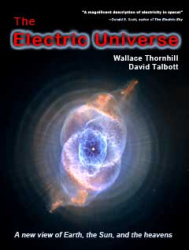|
|
Excerpts From The Electric Universe
Part 5
The following is one of a series of excerpts from The Electric Universe,
copyright © 2002, 2007 Wallace Thornhill and David Talbott and published by
Mikamar Publishing. Reproduced with the kind permission of the authors and publisher.
Presented by Dave Smith
|
|
March 13, 2010
|
|
|
Comets fragmenting is a common occurrence but upon close examination of
such events, many of which take place far from the sun,
it becomes obvious that an electrical explanation offers a far
better fit than the ad hoc adjustment of the
"dirty snowball" model.
Comets and Coronal Mass Ejections
When a coronal mass ejection greeted Comet NEAT, space
scientists called it a spectacular “coincidence.” But in an electric universe
such events deserve a second look.
|
|
|
Page 104
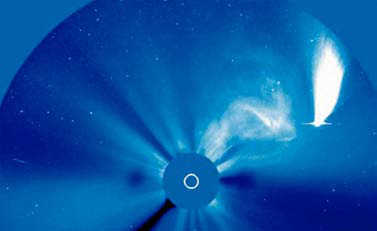
Comet NEAT and a solar CME.
Credit: Solar and Heliospheric
Observatory ESA/NASA (SOHO).
[Click to enlarge]
|
|
|
In 2003, as comet NEAT raced through the extended solar
atmosphere, a large coronal mass ejection (CME) exploded from the
Sun and appeared to strike the comet, causing a 'kink' to propagate
down the comet's tail (see lower left). Of course, for solar physicists,
the timing of the mass ejection could have no connection to the
approach of the comet. However, SOHO has recorded several
instances of comets plunging into the solar corona in 'coincidental'
association with CMEs.
But how would an electric Sun respond to the approach
of a relatively small but strongly charged object? In
electrical terms, the influence of the comet could be far
more significant than its trivial mass in relation to the
Sun. Alfvén considered CMEs to be caused by a
breakdown or breach of the Sun's double layer—an
event that provokes an explosive exchange between the
insulating plasma cell of the Sun and that of the comet.
Hence, it not unreasonable at all to ask if a collision of
a comet's sheath with that of the Sun would cause a
'short-circuit' that could trigger such an explosion.
When Comets Break Apart
As Comet Linear passed its closest distance to the Sun, it was at
its brightest and a prominent dust tail had appeared. Suddenly it
fragmented into 'mini-comets' (see facing page [below]). Astronomers could
find no good reason for its explosive demise. External heat, warming a
kilometers-wide chunk of ice, will produce sublimation of the ice but
will have virtually no effect a few inches beneath the surface. Many
comet watchers began to consider seriously whether comets are
actually loosely aggregated collections of 'mini-comets' that fly apart
when disturbed. But the prior picture of Halley, reinforced by the
subsequent close-ups of Borrelly, Wild 2 and Tempel 1, clearly refutes
this idea.
Page 105
|
|
|
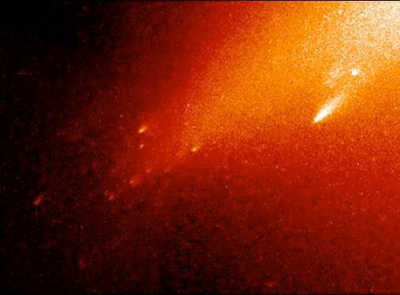
Some comments that accompanied this
image of the fragments of Comet Linear
were, “it was hard to imagine how an
object the size of a mountain could
totally disintegrate in only two weeks.”
And, “The amount of heat available
from sunlight just isn't enough to boil
away something the size of a mountain
in so short a time.”
Credit: NASA, H. Weaver (the Johns
Hopkins University), and
the HST
Comet LINEAR Investigation Team
See: hubblesite.org/gallery/album/solar_system_collection/pr2000027b/
[Click to enlarge]
|
|
|
At the opposite extreme, Comet West never approached
closer than 30 million kilometers to the Sun (half
the distance of Mercury). So astronomers were shocked
when, in 1976, the comet split into four fragments. Comet
Wirtanen fragmented in 1957 a little inside the orbit of
Saturn, and something similar occurred to Comet Biela/
Lambert. In fact, eighty percent of comets that split do so
when they are far from the Sun, according to Carl Sagan
and Anne Druyan in their book Comet.
In a paper published in the 1960s, Dr. Brian G.
Marsden, an astronomer at the Smithsonian Astrophysical
Observatory in Cambridge, Massachusetts, drew attention
to the anomaly of comet fragmentation.110 Discussing the
'sun-grazing' comets, he noted that two instances, 1882 II and 1965
VIII, looked as if they had split apart near aphelion (their farthest
distance from the Sun), well beyond the orbit of Neptune and far
above the ecliptic plane. Moreover, the relative velocity of debris
separation was far greater than could be due to solar heating. “One
really does require an explanation when the velocity of separation is
some 20% of the velocity of the comet itself!” [Emphasis in original
paper.]
Such energetic behavior, however, may be expected of an
electric comet. Discharges within a comet nucleus are equivalent to
the subterranean lightning that causes earthquakes—and just as
unpredictable. The resultant 'comet quake' has equivalent destructive
power and causes the comet to fragment.
According to Sagan and Druyan, “the [splitting] problem is left
unsolved.” But they appear to have found a clue without recognizing
its significance. “Splitting and jetting may be connected.… At the
moment Comet West split, the individual fragments brightened
noticeably, and propelled large quantities of dust into space in the first
of some dozen bursts.”111 The same could be said for the more recent
Comet Linear breakup.
Sudden brightening and explosions of dust are expected to
accompany the electrical fragmentation of a comet nucleus as charge is
exchanged more furiously with the solar wind over a greater total
surface area.
The more sudden the change in a comet's electrical environment,
the more likely that flaring and fragmentation will occur. As we earlier
noted, NASA scientists were astonished to observe a remarkable
300,000 km wide flare-up of comet Halley between the orbits of
Saturn and Uranus. (Under the assumptions of the 'snowball' theory,
Page 106
the nucleus should be frozen and inert at that distance.) But the event
was no accident. It followed some of the largest solar flares ever
recorded.
At the nearest point in its orbit to the Sun, a comet nucleus suffers
the maximum electrical stress. This usually results in an increase in
brightness of the nucleus due to a larger number of cathode arcs
operating simultaneously and more powerfully, explosively removing
more solid material into space to form the dust and ion tails. Both of
these conditions were noted in the case of Comet Linear, suggesting
that the comet was progressing toward an internal discharge.
So it is not surprising to find that fragmentation of comet nuclei is
a common occurrence for long-period comets crossing the plane of the
ecliptic—where the Sun's current density is highest in the solar wind.
They break up not because they are chunks of ice 'warming' in the
Sun, and not because they are aggregations of smaller bodies, but
because of electrical discharges within the nucleus itself.
Comet Schwassmann-Wachmann 3
Schwassmann-Wachmann 3 provides a case study in electrical
fragmentation. The comet was first observed in 1930 and
named after its two German discoverers. It completes an orbit
every 5.4 years, a path that takes it from just beyond the orbit of
Jupiter to inside the orbit of Earth. It does not visit the more
remote regions of the solar system where the spectacular 'Great
Comets' spend long periods adjusting in that more negative
environment of the Sun's domain before racing sunward. What
Schwassmann-Wachmann 3 does exhibit, however, is a highly
elliptical (elongated) orbit, so in electrical terms that means
more rapid transit through the Sun's electric field and more
intense electrical stresses inside the comet nucleus than would
be the case were the comet moving on a less eccentric path.
From its discovery until 1995, it was little more than a footnote in
comet science. The first appearance of the comet that year was so
bright that astronomers hailed it as a new comet. But as it turned out,
the newcomer was Schwassmann-Wachmann 3, presenting itself in
more glorious dress than ever before, despite the fact that conditions
were not favorable. It was 240 million kilometers away but shining
hundreds of times more brightly than expected.
In early 1996, astronomers discovered that the comet had
fragmented into at least three pieces, an occurrence clearly linked to
the spectacular brightening, though no one could say what caused the
event. It also appeared that one or more of the pieces were breaking
into secondary fragments.
|
|
|
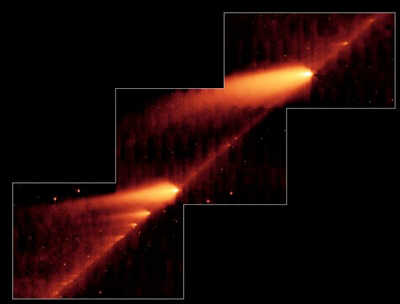
This infrared image from NASA's
Spitzer Space Telescope shows the
broken Comet 73P/Schwassman-
Wachmann 3 skimming along a trail
of debris left during its multiple trips
around the sun. The flame-like
objects are the comet's fragments
and their tails, while the dusty comet
trail is the line bridging the
fragments.
Credit: NASA/JPL-Caltech/W. Reach
(SSC/Caltech)
[Click to enlarge]
|
|
|
When the comet returned in 2000, it was again brighter than
expected, with indications that the disintegration was continuing—or
Page 107
even accelerating. Then, with its most recent appearance, the best
Hubble images showed dozens of fragments, suggesting the possibility
of complete dissolution in a single remaining passage around the Sun.
One astronomer offered this explanation of the comet's
fragmentation: “It's like pouring hot coffee into a glass that's been in
the fridge. The glass shatters from the shock.”112 But that is not a
realistic analogy. The comet is a solid heated from the outside, not a
shell heated from the inside. Attributing fragmentation to internal heat
stress must explain how heat can be transferred rapidly through
hundreds of meters of insulating material, something inconceivable
even if you ignore the deep freeze through which the comet is moving,
with its sunward face continually changing due to rotation.
In addition to citing possible thermal stresses, the Hubble Space
Telescope website offers other possibilities as to why comets might
disintegrate so explosively: “They can also fly apart from rapid
rotation of the nucleus, or explosively pop apart like corks from
champagne bottles due to the outburst of trapped volatile gases.”113
But the centrifugal forces acting on comet nuclei are very small. And
to posit heating in the middle of a kilometers-wide dirty ice
cube is, again, scientifically indefensible.
Perhaps, then, Schwassmann-Wachmann 3 “was shattered
by a hit from a small interplanetary boulder,”114 offered one of
the astronomers quoted above. “Well, make that a series of
one-in-a-trillion hits,” mused a critic of today's comet science.
“That way we can explain the continuing fragmentation over
years.”
When Asteroids Become Comets
According to recent scientific reports, astronomers are
“rethinking long-held beliefs about the distant domains of
comets and asteroids, abodes they've always considered lightyears
apart.” The discovery of asteroids sporting comas has
forced astronomers to speculate that some asteroids are actually
“dirty snowballs in disguise.”
For many years the standard view of asteroids asserted that they
are composed of dust, rock, and metal and that most occupy a belt
between Mars and Jupiter. In contrast, comets were claimed to arrive
from a home in deep space, most coming from the imagined 'Oort
Cloud' at the outermost reaches of the solar system.
|
|
|
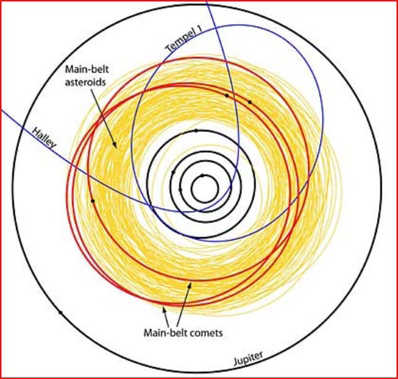
Orbits of the three known main-belt
comets (red lines), the five
innermost planets (black lines: from
the center outward; Mercury, Venus,
Earth, Mars, and Jupiter), a sample
of 100 main-belt asteroids (orange
lines), and two 'typical' comets
(Halley’s Comet, and Tempel 1,
target of the recent Deep Impact
mission) as blue lines. Positions of
the main-belt comets and planets on
March 1, 2006, are plotted with
black dots.
Image credit: Pedro Lacerda (Univ.
Hawaii; Univ. Coimbra, Portugal)
[Click to enlarge]
|
|
|
But now, “the locales of comets and asteroids may not be such a
key distinction,” states Dan Vergano, reporting on the work of two
Page 108
University of Hawaii astronomers, Henry Hsieh and David Jewitt.115
In a survey of 300 asteroids lurking in the asteroid belt, the
astronomers detected three objects that “look a lot like comets …
ejecting little comet tails at times from their surfaces.”116 The three red
circles in the illustration on the previous page describe the orbits of
these 'comet-like' asteroids. One large (140 km) object, Chiron,
mentioned at the beginning of this chapter, is classified as both an
asteroid and a comet. Chiron's orbit is highly eccentric, with perihelion
just inside the orbit of Saturn and aphelion just inside the orbit of
Uranus.
In the electric view, there is no real distinction between a comet
and an asteroid, apart from their orbits. Thus, both Chiron and the
illustration make the point for us: the red circles show greater
variations in orbital distances from the Sun.
|
References:
110
B. G. Marsden, "The Sungrazing Comet Group,"
Astronomical Journal, Vol. 72, p.1170, 1967.
111
C. Sagan & A. Druyan, COMET, pp. 246-7.
112
www.smh.com.au/news/world/comets-breakup-has-scientists-ringside-for-show-ofa-lifetime/2006/04/30/1146335611925.html
113
hubblesite.org/newscenter/archive/releases/2006/18/image/a
114
science.nasa.gov/headlines/y2006/24mar_73p.htm
115
H. Hsieh & D. Jewitt, "A Population of Comets in the Main Asteroid Belt,"
Science, Vol 312, 28 April 2006, pp. 561-3.
116
www.usatoday.com/tech/science/columnist/vergano/2006-03-26-comet-abode_x.htm
|
|
|
|
|
Permalink to this article.
Email this article to a friend
Public comment may be made on this article on the
Thunderbolts Forum/Thunderblogs (free membership required).
To read more from Wal Thornhill please visit:
holoscience.com
|
|
|
|
|
|
|
|
|
YouTube video, first glimpses of Episode Two in the "Symbols of an Alien Sky"
series.
|
|
|
|
|
|
|
Three ebooks in the Universe Electric series are
now available. Consistently
praised for easily understandable text and exquisite graphics.
|
|
|
|
|
|
|
|











